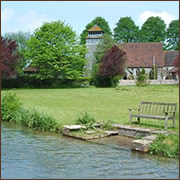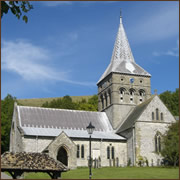Introduction
A walk along the Meon Valley
discovering the churches founded in
the 7th century by Saint Wilfrid
The Meon Valley was one of the last places in England to
hear about Jesus and the Christian Faith. Its villages were
inhabited by Saxons and Jutes and Saint Wilfrid came to live
among them from 681 – 686AD.
The churches he founded remain alongside the River Meon and a ‘Pilgrimage Trail, In the Steps of Saint Wilfrid’ has been designed to encourage modern pilgrims and walkers to discover these churches for themselves – and, maybe,
to learn something about the faith which motivated Wilfrid to leave his palace and live very humbly amongst these foreign settlers.
Booklets describing the Trail may be found in the churches.
Who was Saint Wilfrid?
Wilfrid was born in Northumberland in 634. We know something of his life from the writings of the Venerable Bede in the early eighth century. Wilfrid was born into a wealthy Christian family. His mother died when he was thirteen and he was sent to Lindisfarne to be educated under the Celtic St Aidan. Queen Enflaed of Northumbria was his patron. So, the young Wilfrid had a very good education, impressive connections and, having chosen a religious career, he was sent off to Rome to continue his education. He returned to England in 658 and settled with the Benedictine monks in Ripon Abbey.
It wasn’t long before Wilfrid was caught up in a power struggle in the church between those who favoured the new Roman practices and ideas brought by Augustine rather than the older Celtic traditions. There was something of a north-south divide with the Roman tradition centred at Canterbury and the Celtic tradition in the north. There were great arguments about the timing of Easter and whether monks should shave a tonsure, for example. Wilfrid was instrumental in a victory for the Roman faction at the Conference of Whitby in 664. Shortly afterwards, he was appointed Bishop of York.
In the following years Wilfrid built magnificent stone churches at Hexham, Ripon and York. However, he was soon at the centre of conflict again, having fallen out with Theodore, Archbishop of Canterbury, over the latter’s plans to divide York diocese into two. Wilfrid had to leave York for a while between the years 681 and 686 and it was during this time that he came to the Meon Valley to evangelise the Jutes and Saxons who had recently settled in the area. Wilfrid lived at an extraordinary time for the church. He encountered great controversy, accumulated huge landholdings, befriended kings and rulers across Europe and travelled to Rome three times on horseback and on foot. He suffered shipwreck and was nearly murdered several times – once by natives off the coast of Sussex. He had been a bishop for forty five years and a pillar of the church during one of the most turbulent periods of its history as it sought to establish itself in a pagan land. Wilfrid died on 12th October 709 at the Minster church of St Andrew’s, Oundle.
Wilfrid and the Meon Valley
According to Bede, the men of South West Sussex and the Meon Valley were “ignorant of the name and faith of God”. Just before Wilfrid’s arrival there had been the most terrible famine and the distress was so acute that often "forty or fifty, being spent with want, would go together to some cliff, or to the seashore, and there, hand-in-hand, miserably perish by the fall or be swallowed by the waves."
 |
Meonstoke Church |
|
Although there were fish enough to eat in the rivers and sea, the poor country folk did not know how to catch them and could only fish for eels. Wilfrid borrowed these nets and, casting them into the sea, "by the blessing of God immediately took three hundred fishes of different kinds, which they divided into three parts, giving a hundred to the poor, a hundred to those who had lent them the nets and keeping a hundred for their own use. By this act of kindness the Bishop gained the affections of them all and they began more readily, at his preaching, to hope for heavenly goods; seeing that, by his help, they had received those which are temporal." |
And so, Wilfrid followed the teaching of Christ, himself, as he first fed the people of the Meon Valley and then went on to tell them all about God’s love and grace. In grateful acknowledgement of his work, King Aethelwalh of Sussex gave Wilfrid land at Selsey in 681 on which a cathedral was built. It is now thought to be under the sea. Wilfrid went on to befriend and convert King Caedwalla of Wessex and evangelised the Isle of Wight, before turning to what is now Titchfield and the Meon Valley, founding many of the churches which are the subject of our Pilgrimage Trail.
The Meon Valley was one of the last places in England to hear about Jesus and the Christian Faith. Its villages were inhabited by Saxons and Jutes and Saint Wilfrid came to live among them from 681 – 686AD.
The churches he founded remain alongside the River Meon and a ‘Pilgrimage Trail, In the Steps of Saint Wilfrid’ has been designed to encourage modern pilgrims and walkers to discover these churches for themselves – and, maybe,
to learn something about the faith which motivated Wilfrid to leave his palace and live very humbly amongst these foreign settlers. |
 |
East
Meon
Church |
|
Location Map
Below is a map showing the position of the relative
churches. You can use the controls in the top right corner
to zoom in or move about on the map. Just click on any
of the blue markers to see the name of the church and
to get directions to that church. For a larger map, please
click on the link below the map.
View Larger Map
Booklets describing the Trail may be found in the
churches. |

